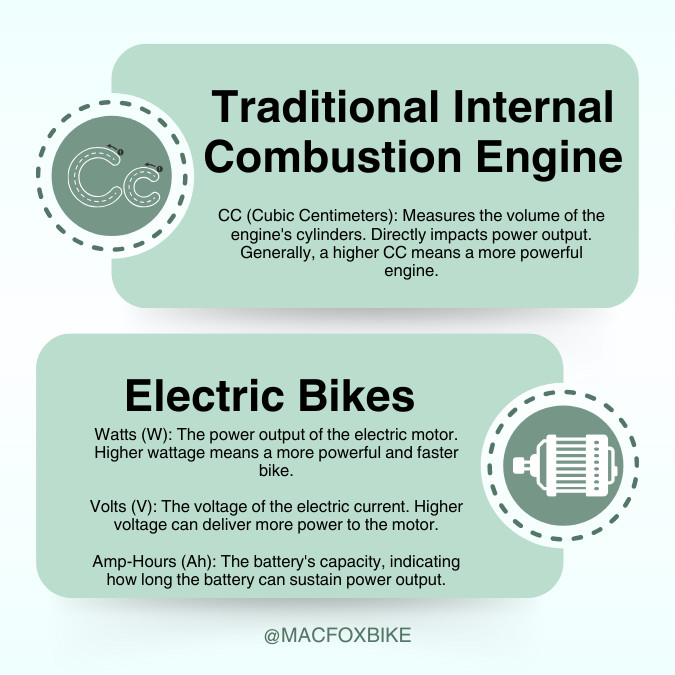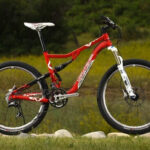Are you curious about the power of an electric bike compared to a traditional motorcycle? It’s a common question among those transitioning from gas-powered bikes to electric ones, especially since “CC” has long been the standard for measuring engine power. At usabikers.net, we’ll help you understand how electric bike power is measured and what factors to consider when choosing the right e-bike for your needs, focusing on wattage, voltage, and amp-hours. Let’s explore e-bike specifications, electric motors, and battery capacity to clear up any confusion.
1. What Does “CC” Mean in Relation to Vehicles?
“CC” stands for cubic centimeters, which measures the volume of an engine’s cylinders, determining how much air and fuel it can intake, mix, and burn to generate power. More CCs generally translate to greater power in gasoline engines, where a 1000cc motorcycle offers significantly more power and speed than a 250cc counterpart. However, this measurement doesn’t apply to electric bikes because they use electric motors powered by batteries, not combustion engines with cylinders.
This concept is crucial to understand for anyone transitioning from traditional motorcycles to electric bikes. According to research from the Motorcycle Industry Council (MIC) in July 2023, interest in electric motorcycles and e-bikes is growing, but many potential buyers are unfamiliar with the different performance metrics. The MIC emphasizes the need for clear and accessible information about electric vehicle power, helping riders make informed decisions. Understanding the absence of CCs in electric bikes is the first step toward grasping the alternative measurements used to define their capabilities.
 Electric Bike Power
Electric Bike Power
2. How Are Electric Bikes and Their Power Measured?
Electric bikes are measured using Watts (W), Volts (V), and Amp-Hours (Ah) instead of CCs, each providing a different insight into the bike’s performance:
- Watts (W): This is the power output of the electric motor. Higher wattage typically means more power and speed.
- Volts (V): Voltage is the electrical current’s force. Higher voltage provides more power for motor applications, improving overall performance.
- Amp-Hours (Ah): This measures how long a battery can sustain power output, indicating the battery’s capacity and range.
Unlike gasoline engines that rely on increasing CC counts to measure engine power, electric bikes depend on these electrical factors to determine their performance capabilities. For example, an electric bike with a 750W motor generally provides more power than one with a 250W motor. This difference in power is crucial when considering the bike’s intended use, such as commuting in flat urban areas or tackling steep hills and off-road terrains.
3. Can CCs Be Converted to Electric Bike Units (Watts)?
There isn’t a direct conversion formula from CCs to Watts because they measure different aspects: engine capacity versus electrical power output. However, we can make rough estimates for comparison:
For example, a 50cc gas scooter might produce 2-3 horsepower, roughly equivalent to 1500-2200 watts in an electric motor.
It’s important to remember that these estimates are approximate. Electric motors deliver power differently than gasoline engines, often providing instant torque. This can make an electric bike feel more robust and responsive than a gas bike with similar “power.”
4. How Can the Power of an Electric Bike Be Determined?
If CCs don’t apply, how do you assess whether an electric bike has sufficient power for your needs? Here’s what to consider:
- Motor Power (Watts): Higher wattage generally means more power. A 250W motor is excellent for city commuting, while a 750W or 1000W motor is better for hills and off-road terrain.
- Voltage (Volts): Higher voltage can enhance an electric bike’s performance. Common voltages range from 36V to 48V for standard models, with higher-end options offering 52V or more.
- Torque: Measured in Newton-meters (Nm), torque indicates the motor’s “oomph” when you twist the throttle. More torque means quicker acceleration and better hill-climbing ability.
Consider your planned riding conditions when selecting an electric bicycle. A motor with 250W to 500W power will likely suffice for casual city riding. For steep hills or off-road terrain, invest in a bike with at least 750W of power output.
5. What Is the Difference Between Electric Bikes and Gasoline Motorcycles?
Comparing electric bikes and gasoline motorcycles involves understanding the variances in performance metrics. A 1000W electric bike cannot match a 600cc motorcycle in terms of top speed or acceleration. However, electric bikes offer advantages such as instant torque delivery, quiet operation, and reduced maintenance.
An electric bike with a 500W motor may reach 20-28 mph, depending on local laws, while 50cc scooters typically top out between 30-40 mph. For daily commutes in a city, the difference might not be significant. Electric bikes offer the added benefit of access to bike lanes and trails, which often do not permit motorcycle use.
6. What Practical Advice Should Be Considered Before Buying an Electric Bike?
Before purchasing an e-bike, carefully assess your riding needs. Consider the following:
- Terrain: Will you be riding in flat cities or hilly terrain?
- Priorities: Do you require speed, or is range more important?
For urban commuters, a 250W to 500W motor with a 36V or 48V battery might suffice. If you need more power, look for models with motors of at least 750W. Always consult local regulations regarding e-bike power and speed limitations, as some areas have stringent rules and speed restrictions.
7. How Can I Choose the Right Electric Bike for My Needs?
To choose the right electric bike, consider several factors:
- Riding Style: Determine whether you need the bike for commuting, recreation, or off-road adventures.
- Terrain: Select a motor power suitable for the terrain you’ll be riding on, with higher wattage for hills and rough terrain.
- Battery Capacity: Ensure the battery provides enough range for your typical rides, considering voltage and amp-hours.
- Local Laws: Be aware of and comply with local regulations regarding e-bike power and speed limits.
- Budget: Balance your performance needs with your budget, exploring different models and brands that offer the best value for your requirements.
8. What Are the Benefits of Switching to an Electric Bike?
Switching to an electric bike offers numerous benefits that cater to a wide range of riders:
- Eco-Friendly: Electric bikes produce zero emissions, contributing to cleaner air and a reduced carbon footprint, aligning with growing environmental concerns.
- Cost-Effective: E-bikes are cheaper to operate than gasoline vehicles, with lower fuel costs and reduced maintenance needs.
- Health Benefits: Riding an e-bike provides physical exercise, improving cardiovascular health and overall fitness.
- Convenience: E-bikes can access bike lanes and trails, offering a convenient way to navigate urban areas and avoid traffic congestion.
- Versatility: With various models available, e-bikes can be tailored for commuting, recreation, fitness, and off-road adventures.
9. What Maintenance Is Required for Electric Bikes?
Electric bikes generally require less maintenance than gasoline motorcycles due to fewer moving parts and the absence of an internal combustion engine:
- Battery Care: Regularly charge the battery and store it properly to maximize its lifespan.
- Tire Maintenance: Keep tires inflated to the correct pressure and inspect them for wear and tear.
- Brake Inspection: Regularly check brake pads and cables for wear and ensure they function correctly.
- Chain Maintenance: Keep the chain clean and lubricated for smooth operation.
- Motor and Electrical Components: Periodically inspect the motor and electrical components for any signs of damage or wear.
10. How Do I Stay Safe While Riding an Electric Bike?
Safety is paramount when riding an electric bike. Here are essential safety tips to keep in mind:
- Wear a Helmet: Always wear a properly fitted helmet to protect your head in case of a fall. According to the National Highway Traffic Safety Administration (NHTSA), helmets reduce the risk of head injury by 69%.
- Follow Traffic Laws: Obey all traffic laws and regulations, including speed limits, traffic signals, and lane markings.
- Use Hand Signals: Use clear hand signals to indicate turns and stops to other road users.
- Be Visible: Wear bright clothing and use lights, especially when riding at night or in low-light conditions.
- Maintain Your Bike: Regularly inspect and maintain your e-bike to ensure it is in good working condition.
- Take a Safety Course: Consider taking an e-bike safety course to learn essential riding skills and safety techniques.
- Be Aware of Your Surroundings: Pay attention to traffic, pedestrians, and other potential hazards.
- Avoid Distractions: Do not use electronic devices or engage in other distracting activities while riding.
Conclusion
Electric bikes don’t use cubic centimeters to measure power; instead, they rely on watts, volts, and amp-hours. Understanding these terms might seem complex initially, but it’s essential for selecting an electric bike that best meets your needs. At usabikers.net, we aim to provide clear, helpful information to make your transition to electric biking smooth and enjoyable.
Ready to explore the world of electric bikes? Visit usabikers.net today to discover more articles, reviews, and community forums. Whether you’re a seasoned biker or new to the world of e-bikes, we have the resources you need to make informed decisions and enhance your riding experience.
Address: 801 Sturgis Main St, Sturgis, SD 57785, United States
Phone: +1 (605) 347-2000
Website: usabikers.net
FAQs
Do Electric Bikes Have an Equivalent CC Rating?
No, electric bikes do not have an equivalent CC rating because they operate under different principles. Watts and volts are commonly measured for electric bikes to determine their power and performance capabilities.
How Does Electric Bike Power Affect Performance?
Higher power, measured in wattage, typically results in better acceleration, higher top speeds, and improved hill-climbing ability. However, it also leads to faster battery drain, so balancing power with battery capacity is essential.
Does a Higher Wattage Always Offer Advantages?
Not necessarily. While increased wattage could mean more extraordinary power, the range may be reduced significantly if your battery cannot support this additional load. Consider your riding needs and typical distances to find the right balance.
What Is the Ideal Voltage for an Electric Bike?
The ideal voltage for an electric bike depends on your riding needs. Common voltages range from 36V to 48V for standard models, with higher-end options offering 52V or more for enhanced performance.
How Important Is Torque in an Electric Bike?
Torque is very important in an electric bike because it indicates the motor’s “oomph” when you twist the throttle. More torque means quicker acceleration and better hill-climbing ability, making it a crucial factor for performance.
Can I Ride an Electric Bike on Bike Lanes?
Yes, you can ride an electric bike on bike lanes, which is a significant advantage over motorcycles. This allows you to navigate urban areas more conveniently and avoid traffic congestion.
Are Electric Bikes Environmentally Friendly?
Yes, electric bikes are environmentally friendly because they produce zero emissions, contributing to cleaner air and a reduced carbon footprint. This makes them a sustainable transportation option.
What Is the Typical Range of an Electric Bike Battery?
The typical range of an electric bike battery varies depending on factors such as battery capacity, motor power, terrain, and riding style. However, most e-bikes can travel between 20 to 50 miles on a single charge.
Do Electric Bikes Require Special Maintenance?
Electric bikes require less maintenance than gasoline motorcycles, but regular care is still essential. Key maintenance tasks include battery care, tire maintenance, brake inspection, and chain maintenance.
Are There Any Regulations for Electric Bikes?
Yes, there are regulations for electric bikes that vary by location. Always consult local regulations regarding e-bike power and speed limitations to ensure compliance and safe riding.


